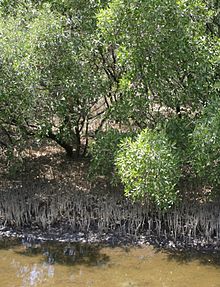| This article's lead section may be too long. Please read the length guidelines and help move details into the article's body. (September 2023) |
| Black mangrove | |
|---|---|

| |
| Black mangrove growing in Guanacaste Province, Costa Rica | |
| Conservation status | |
 Least Concern (IUCN 3.1) | |
| Scientific classification | |
| Kingdom: | Plantae |
| Clade: | Tracheophytes |
| Clade: | Angiosperms |
| Clade: | Eudicots |
| Clade: | Asterids |
| Order: | Lamiales |
| Family: | Acanthaceae |
| Genus: | Avicennia |
| Species: | A. germinans |
| Binomial name | |
| Avicennia germinans (L.) L. | |

| |
| Distribution of Avicennia germinans | |
| Synonyms | |
| |
Avicennia germinans, the black mangrove, is a shrub or small tree growing up to 12 meters (39 feet) in the acanthus family, Acanthaceae. It grows in tropical and subtropical regions of the Americas, on both the Atlantic and Pacific Coasts, and on the Atlantic Coast of tropical Africa, where it thrives on the sandy and muddy shores where seawater reaches. It is common throughout coastal areas of Texas and Florida, and ranges as far north as southern Louisiana and northern Florida in the United States.
Like many other mangrove species, it reproduces by vivipary. Seeds are encased in a fruit, which reveals the germinated seedling when it falls into the water.
Unlike other mangrove species, it does not grow on prop roots, but possesses pneumatophores that allow its roots to breathe even when submerged. It is a hardy species and expels absorbed salt mainly from its leathery leaves.
The name "black mangrove" refers to the color of the trunk and heartwood. The leaves often appear whitish from the salt excreted at night and on cloudy days. It is often found in its native range with the red mangrove (Rhizophora mangle) and the white mangrove (Laguncularia racemosa). White mangroves grow inland from black mangroves, which themselves grow inland from red mangroves. The three species work together to stabilize the shoreline, provide buffers from storm surges, trap debris and detritus brought in by tides, and provide feeding, breeding, and nursery grounds for a great variety of fish, shellfish, birds, and other wildlife.
Habitat


The black mangrove grows just above the high tide in coastal areas. It is less tolerant of highly saline conditions than certain other species that occur in mangrove ecosystems. It can reach 10–15 m (33–49 ft) in height, although it is a small shrub in cooler regions of its range. The seeds germinate in midsummer, but may be seen all year on the trees. The seeds can remain viable for over a year once released.
Wood
| This section does not cite any sources. Please help improve this section by adding citations to reliable sources. Unsourced material may be challenged and removed. (September 2023) (Learn how and when to remove this message) |
The heartwood is dark-brown to black, while the sapwood is yellow-brown. It has the unusual property of having less dense heartwood than sapwood. The sapwood sinks in water while the heartwood floats. The wood is strong, heavy, and hard, but is difficult to work due to its interlocked grain, and is somewhat difficult to finish due to its oily texture. Uses include posts, pilings, charcoal, and fuel. Despite growing in a marine environment, the dry wood is subject to attack by marine borers and termites. Like many species, it contains tannins in the bark and has been used to tan leather products.
References
- Ellison, A.; Farnsworth, E.; Moore, G. (2010). "Avicennia germinans". IUCN Red List of Threatened Species. 2010: e.T178811A7613866. doi:10.2305/IUCN.UK.2010-2.RLTS.T178811A7613866.en. Retrieved 28 October 2022.
- "Avicennia germinans". Retrieved 2019-05-10.
- Madrid, Eric N.; Armitage, Anna R.; López-Portillo, Jorge (2014). "Avicennia germinans (black mangrove) vessel architecture is linked to chilling and salinity tolerance in the Gulf of Mexico". Frontiers in Plant Science. 5: 503. doi:10.3389/fpls.2014.00503. PMC 4176030. PMID 25309570.
- World Wildlife Fund. 2010. Petenes mangroves. eds. Mark McGinley, C.Michael Hogan & C. Cleveland. Encyclopedia of Earth. National Council for Science and the Environment. Washington DC
Further reading
- Haehle, Robert (1999). Native Florida Plants. Houston: Gulf Publishing Company. ISBN 0-88415-425-4.
- McKee, Karen L.; Mendelssohn, Irving A.; Hester, Mark W. (1988). "Reexamination of pore water sulfide concentrations and redox potentials near the aerial roots of Rhizophora mangle and Avicennia germinans". American Journal of Botany. 75 (9): 1352–9. doi:10.1002/j.1537-2197.1988.tb14196.x. JSTOR 2444458.
External links
![]() Media related to Avicennia germinans at Wikimedia Commons
Media related to Avicennia germinans at Wikimedia Commons
- Interactive Distribution Map of Avicennia germinans Archived 2017-07-06 at the Wayback Machine
- Avicennia germinans in West African plants – A Photo Guide.
![]() Data related to Avicennia germinans at Wikispecies
Data related to Avicennia germinans at Wikispecies
| Taxon identifiers | |
|---|---|
| Avicennia germinans |
|
- IUCN Red List least concern species
- Avicennia
- Mangroves
- Halophytes
- Afrotropical realm flora
- Neotropical realm flora
- Tropical Atlantic flora
- Tropical Eastern Pacific flora
- Trees of Africa
- Trees of Northern America
- Trees of Central America
- Trees of South America
- Trees of the Caribbean
- Plants described in 1764
- Taxa named by Carl Linnaeus